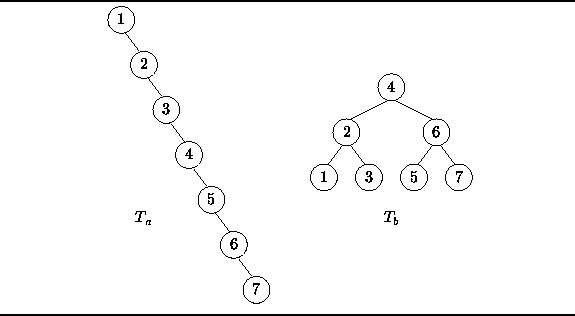|
Data Structures and Algorithms
with Object-Oriented Design Patterns in C# |
The search method described above applies directly to binary search trees. As above, the search begins at the root node of the tree. If the object of the search, x, matches the root r, the search terminates successfully. If it does not, then if x is less than r, the left subtree is searched; otherwise x must be greater than r, in which case the right subtree is searched.
Figure ![]() shows two binary search trees.
The tree
shows two binary search trees.
The tree ![]() is an example of a particularly bad search tree
because it is not really very tree-like at all.
In fact, it is topologically isomorphic with a linear, linked list.
In the worst case, a tree which contains n items has height O(n).
Therefore, in the worst case an unsuccessful search must visit O(n)
internal nodes.
is an example of a particularly bad search tree
because it is not really very tree-like at all.
In fact, it is topologically isomorphic with a linear, linked list.
In the worst case, a tree which contains n items has height O(n).
Therefore, in the worst case an unsuccessful search must visit O(n)
internal nodes.

Figure: Examples of search trees.
On the other hand,
tree ![]() in Figure
in Figure ![]() is an example of a particularly good binary search tree.
This tree is an instance of
a perfect binary tree .
is an example of a particularly good binary search tree.
This tree is an instance of
a perfect binary tree .
Definition (Perfect Binary Tree) A perfect binary tree of heightis a binary tree
with the following properties:
- If h=0, then
and
.
- Otherwise, h>0, in which case both
and
are both perfect binary trees of height h-1.
It is fairly easy to show that a perfect binary tree of height h
has exactly ![]() internal nodes.
Conversely, the height of a perfect binary tree with n internal nodes
is
internal nodes.
Conversely, the height of a perfect binary tree with n internal nodes
is ![]() .
If we have a search tree that has the shape of a perfect binary tree,
then every unsuccessful search visits exactly h+1 internal nodes,
where
.
If we have a search tree that has the shape of a perfect binary tree,
then every unsuccessful search visits exactly h+1 internal nodes,
where ![]() .
Thus, the worst case for unsuccessful search in a perfect tree is
.
Thus, the worst case for unsuccessful search in a perfect tree is ![]() .
.